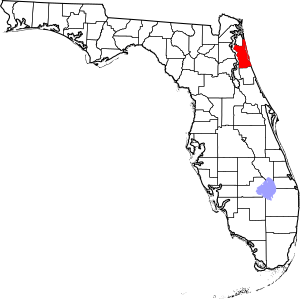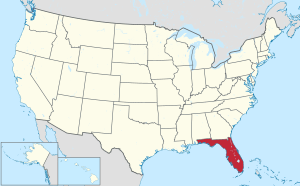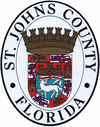St. Johns County, Florida facts for kids
Quick facts for kids
St. Johns County
|
|||
|---|---|---|---|

St. Johns County Courthouse
|
|||
|
|||

Location within the U.S. state of Florida
|
|||
 Florida's location within the U.S. |
|||
| Country | |||
| State | |||
| Founded | July 21, 1821 | ||
| Named for | San Juan del Puerto | ||
| Seat | St. Augustine | ||
| Largest city | St. Augustine | ||
| Area | |||
| • Total | 822 sq mi (2,130 km2) | ||
| • Land | 601 sq mi (1,560 km2) | ||
| • Water | 221 sq mi (570 km2) 26.9%% | ||
| Population
(2020)
|
|||
| • Total | 273,425 | ||
| • Density | 440/sq mi (170/km2) | ||
| Time zone | UTC−5 (Eastern) | ||
| • Summer (DST) | UTC−4 (EDT) | ||
| Congressional districts | 4th, 6th | ||
St. Johns County is a county in the northeastern part of the U.S. state of Florida. As of the 2020 United States Census, its population was 273,425. The county seat and largest incorporated city is St. Augustine. St. Johns County is part of the Jacksonville metropolitan area.
The county was established in 1821. It is one of the two original counties established after Florida was ceded to the United States, at the start of the Florida Territorial period, and corresponded roughly to the former colonial province of East Florida. It was named for the St. Johns River, which runs along its western border.
Today, St. Johns County primarily comprises residential bedroom communities for those who commute to Jacksonville. Tourism, primarily associated with St. Augustine and the many golf courses in the area, is the chief economic industry.
There is also an unincorporated community named Saint Johns in northwestern St. Johns County.
Contents
Demographics
| Historical population | |||
|---|---|---|---|
| Census | Pop. | %± | |
| 1830 | 2,583 | — | |
| 1840 | 2,694 | 4.3% | |
| 1850 | 2,525 | −6.3% | |
| 1860 | 3,038 | 20.3% | |
| 1870 | 2,618 | −13.8% | |
| 1880 | 4,535 | 73.2% | |
| 1890 | 8,712 | 92.1% | |
| 1900 | 9,165 | 5.2% | |
| 1910 | 13,208 | 44.1% | |
| 1920 | 13,061 | −1.1% | |
| 1930 | 18,676 | 43.0% | |
| 1940 | 20,012 | 7.2% | |
| 1950 | 24,998 | 24.9% | |
| 1960 | 30,034 | 20.1% | |
| 1970 | 30,727 | 2.3% | |
| 1980 | 51,303 | 67.0% | |
| 1990 | 83,829 | 63.4% | |
| 2000 | 123,135 | 46.9% | |
| 2010 | 190,039 | 54.3% | |
| 2020 | 273,425 | 43.9% | |
| U.S. Decennial Census 1790-1960 1900-1990 1990-2000 2010, 2020 |
|||
As of the census of 2000, there were 123,135 people, 49,614 households, and 34,084 families residing in the county. The population density was 202 people per square mile (78/km2). There were 58,008 housing units at an average density of 95 per square mile (37/km2). The racial makeup of the county was 90.92% White, 6.29% African American, 0.26% American Indian, 0.95% Asian, 0.05% Pacific Islander, 0.55% from other races, and 0.97% from two or more races. Hispanic or Latino of any race were 15.8% of the population.
There were 49,614 households, of which 29.2% had children under age 18 living with them, 56.8% were married couples living together, 8.9% had a female householder with no husband present, and 31.3% were non-families. 24.3% of all households were made up of individuals, and 9.4% had someone living alone who was 65 or older. The average household size was 2.44 and the average family size was 2.90.
The age of the population was spread out, with 23.1% under 18, 7.0% from 18 to 24, 27.6% from 25 to 44, 26.4% from 45 to 64, and 15.9% who were 65 or older. The median age was 41. For every 100 females there were 94.5 males. For every 100 females 18 and older, there were 91.5 males.
The median household income was $50,099, and the median family income was $59,153. Males had a median income of $40,783 versus $27,240 for females. The per capita income was $28,674. About 5.1% of families and 8.0% of the population were below the poverty line, including 9.3% of those under 18 and 6.2% of those 65 or older.
Education
Primary and secondary education
Public schools are run by the St. Johns County School District, headed by the St. Johns County School Board, an elected five-member board which appoints a superintendent to administer school operations. The system has grown considerably since 2000 to accommodate the county's rapid population growth. It is Florida's top-performing school district in Florida Comprehensive Assessment Test scores, the state's standardized test for public schools. The district also received the 2011 Energy Star Top Performer and Leader from the EPA.
For the 2014–15 school year the district comprised:
- 18 elementary schools (K–5)
- 3 K-8 school (K–8)
- 7 middle schools (6–8)
- 7 high schools (9–12)
- 1 alternative center (K-12)
- 6 charter schools (including a vocational-technical college)
- 1 virtual school
The St. Johns County School District has a robust special education department serving the needs of students with autism, cerebral palsy, and cognitive disabilities. The Florida School for the Deaf and Blind is a residential school for deaf and blind students, funded and operated by the state of Florida. The Catholic Diocese of St. Augustine operates St. Joseph Academy, a private high school in St. Augustine.
St. Johns County schools have received a state government grade of "A" for their work with the students and FCAT grading from 2004 to 2014.
Higher education
St. Johns River State College, a state college in the Florida College System, has a campus in St. Johns County near St. Augustine. It is accredited by the Southern Association of Colleges and Schools to award associates degrees and two bachelor's degrees.
Flagler College is a private liberal arts institution in downtown St. Augustine. U.S. News & World Report has recognized it as a "Best Value College".
University of St. Augustine for Health Sciences is a school for physical and occupational therapy education.
Transportation
Airports
- Northeast Florida Regional Airport
- Jacksonville International Airport (JAX) is about 35 miles to the north (in Duval County).
Highways
 US 1
US 1
 US 1 Bus.
US 1 Bus. SR 9B
SR 9B SR 13
SR 13 SR 16
SR 16 SR 206
SR 206 SR 207
SR 207 SR 312
SR 312 Dixie Highway
Dixie Highway
See also
 In Spanish: Condado de San Juan (Florida) para niños
In Spanish: Condado de San Juan (Florida) para niños



